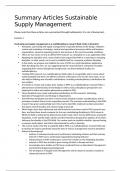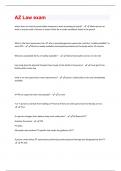Summary Articles Sustainable
Supply Management
Please note that these articles are summarized through bulletpoints: It is not a flowing text.
Lecture 1
Purchasing and supply management as a multidisciplinary research field: Unity in diversity?
Nowadays, purchasing and supply management is typically defined as the design, initiation,
control and evaluation of strategic, tactical and operational processes within and between
organizations, aimed at acquiring products and services at the most favourable conditions.
There are two views on how to define PSM research: as a discipline or as an application field
Adopting the discipline view, most scholars have argued that PSM is a maturing or emerging
discipline, in other words, on its way to establish itself as a separate academic discipline
In this study, we propose and validate the view of PSM as a multi-disciplinary application
field. By taking this view, we are suggesting that the research field is composed of studies
originating from various disciplinary backgrounds, not that individual studies are
multidisciplinary.
Treating PSM research as a multidisciplinary field makes it recognizable and to some extent
understandable that there are different streams of literature even for the same topic. It can
also help in defining new scientific contributions, including interdisciplinary contributions for
new studies.
It is timely to review and analyse prior studies in PSM as a multidisciplinary research field; a
phenomenon-centered body of knowledge in which various disciplinary perspectives are
employed to define and explain phenomena related to PSM.
Three disciplines have made substantial contributions to PSM research: Marketing,
Operations Management and Strategy & Organization.
How PSM has developed over time in terms of the absolute number of publications and its
prevalence (market share) in the respective journals: The common understanding is that PSM
research has grown substantially over time, but to date little evidence has been presented
that spans several decades and a broad range of journals.
Which topics have been addressed and which theories have been used in PSM research over
time, and how these trends compare for the core contributing disciplines to PSM research.
While the field is united by the phenomena under study, there may be differences among the
disciplines, in the specific topics studies and the theoretical perspectives applied, all of which,
influence the identity of the PSM field. Our review seeks to establish whether, beyond having
a common study object, the field is characterised by unity in diversity.
The current study is the first to explicitly define PSM as a multidisciplinary research field and
to develop its inquiry specifically along the lines of various management research disciplines
Historical development
o authors of milestone books were (well-known) marketing scholars and their primary
interest in PSM was to understand organizational buying behavior
o Advancements in PSM continued to come from scholars in the Marketing discipline
o Interest in PSM also started to grow among scholars in Europe and Asia
o Increasingly more studies on PSM were conducted from an Operations Management
and Industrial Engineering background
o The emergence of Supply Chain Management and its impact in practice created an
enhanced interest in PSM
, o Although there were still some studies on PSM from a Marketing background, it
seems the discipline gradually became less dominant
o PSM increasingly evolved into a phenomenon of interest to scholars in Strategic
Management and Organization Theory
Within the realm of management research, three disciplines have thus played a pivotal role
in the development of PSM research: Operations management (OM), Marketing (MA) and
Strategy and Organization (SO). We describe these disciplines as reference disciplines as they
provide the theoretical frameworks that PSM researchers use
o Operations Management: study of the transformation processes that create
products or services in all organizations, for profit and non profit. Study of effective
and efficient transformation processes, in particular, production and logistics.
o Marketing: study of the organizational function and the processes for creating,
communicating and delivering value to customers and for managing customer
relationships in ways that benefit the organization and its stakeholders
o Strategy and Organization: building and testing theory about organizations, their
members and their management, organization-environment relations, and
organizing processes. SO has also been particularly instrumental in providing theories
to study PSM phenomena.
o Other management research disciplines focus on a limited range of specific topics
related to PSM, whereas the MA, OM and SO disciplines study research questions
and contribute theories spanning a range of phenomena within PSM research.
Having illustrated that PSM research is largely composed of research that stems from three
disciplines, it may be useful to reflect on the alternative potential approaches for
multidisciplinary research development. Disciplines can evolve along two different
trajectories: intradisciplinary and interdisciplinary.
o Intradisciplinary evolution takes place via ‘differentiation’, by studying a topic in
increasing specificity and via creating ‘fractals’, in which a topic is studied in
increasingly smaller units of observation, using the same concepts.
o Interdisciplinary research: three forms of research involving multiple disciplines:
Multidisciplinary research—“working with several disciplines” —draws on
knowledge from different disciplines but does not change these different
perspectives; it only contrasts them.
Interdisciplinary research—“working between several disciplines” —
synthesizes and integrates knowledge.
Transdisciplinary research—“working across and beyond several disciplines”
—transcends traditional boundaries, creating new understanding and
theories.
The current study seeks to identify the multidisciplinary coexistence of different PSM
disciplinary research streams; i.e. to what extent the field is composed of knowledge
developed in different disciplines and how these different streams have developed
quantitively and content-wise over time.
One can conclude at an aggregate level that research attention shifted from strategic to
tactical/operational PSM processes, which is at odds with the common notion that PSM
practice and research have increasingly emphasised strategic aspects. The explanation
may be that as the body of studies on strategic processes accumulates, researchers perceive
less need or contribution potential for such studies.
There are also some notable differences between the disciplines in terms of the topics they
study. This would obviously limit the potential for interdisciplinary collaboration.
The use of theory has substantially increased over time, and TCE and RBV have been the
most prevalent theoretical frameworks across the journal groups. Beyond these two
, theories, the popularity of theories in the journal groups varies, but the dominant set of
theories is quite stable for each journal group – except for the PSM journals, where
there are quite some changes in the relative prevalence of theories.
When PSM is defined as a monodisciplinary field of research, emphasis is put on the
development of a distinct and coherent set of theories and terminologies, and unique
standards or forms of research methods.
Not considering the entire, multidisciplinary body of research in PSM – or not making any
differentiation – hinders a good understanding of the current situation in our research field
and of the potential for further development.
There is disagreement as to which larger discipline PSM research belongs
PSM research cannot be seen as a single discipline and that there are clear differences
between the contributions of the disciplines that compose the field.
o PSM research published in OM journals is characterised by a relatively strong
emphasis on tactical/ operational processes and on performance outcomes
(competitive priorities). OM-based PSM research has relied less extensively on
formally defined grand theories, but when it does, it has relied (like the other journal
groups) extensively on Transaction Cost Economics (TCE), but also on Game Theory
and Agency Theory.
o PSM research in MA journals has strongly focused on strategic processes and in
particular on SRM.
o PSM research in SO journals has also strongly focused on SRM but Make-or-Buy
studies have been a close second. Contract has recently become a less popular topic.
Innovation as a competitive priority has also been significantly more popular in SO
than in other journal groups. Compared to other journal groups, SO-based studies
are more often based on grand theories, in particular the Resource-Based View (RBV)
and the Knowledge-Based View (KBV) of the firm (next to TCE).
o Finally, research in the specialised PSM journals has been the most diversified. This
was to some extent to be expected, as these specialist journals cannot be assigned to
one specific discipline. PSM studies in the specialised journals have been somewhat
more ‘theory-oriented’ than OM-based studies, but less so than those in MA and SO.
The specialist journals have also been the most diverse in the theories they use,
especially in the later periods, with TCE and RBV having been the most popular.
There are also similarities across the four journal groups
o SRM has been a popular topic throughout, and the five most popular topics for each
of the journal groups, in any given period, overlap to a high degree. With one
exception, TCE is the most popular for all journal groups in all periods.
PSM research, as measured by the topics and theories adopted in journal publications in the
recent two decades, is characterised by ‘unity in diversity’. There has been diversity, with
distinct features of each journal group in terms of the one or two most popular topics or
theories but considering the broader base of PSM publications in each journal group, there is
considerable overlap.
More than one-third of all PSM articles refer explicitly to one or more grand theories. Across
the entire review period, the use of theory has more than doubled, although there seems to
have been a drop again recently – except in the specialist journals.
The total number of publications tripled in the most recent lustrum compared to the first,
particularly driven by the OM journals. This growth was not only due to journals publishing
more articles in a given period; journals also increased their dedication to PSM research.
This is a strong indicator of the high and growing scientific relevance of our field, especially
considering this review only includes highly cited journals.
, Considering PSM as a multidisciplinary application field changes the type of research
questions that researchers ask and their understanding of what constitutes valuable
contributions to PSM research.
Taking such a view holds an intrinsic appreciation of diversity and opens one's eyes to how
different disciplines may interact within the field and influence one another.
For researchers, this study leads to two recommendations related to
the multidisciplinary nature of the PSM research field.
o Understanding and acknowledging that PSM research is a multidisciplinary field could help
researchers to map previous research and any differences and similarities in terms of
theories applied, but also in terms of research methods used (an aspect not covered in this
article).
o The multidisciplinary perspective subsequently helps to define a more precise contribution
for new studies.
Lecture 2
Handling measurement issues and strategic directions in Kraljic's purchasing portfolio model
Purchasing portfolio models aim at developing differentiated purchasing and supplier
strategies.
Kraljic (1983) introduced the first comprehensive portfolio approach for purchasing and
supply management.
Kraljic’s approach includes the construction of a portfolio matrix that classifies products on
the basis of two dimensions: profit impact and supply risk (‘low’ and ‘high’). The result is a 2
2 matrix and a classification in four categories: bottleneck, non-critical, leverage and strategic
items, see Fig. 1.
Non-critical items require efficient processing, product standardization, order volume and
inventory optimalization.





